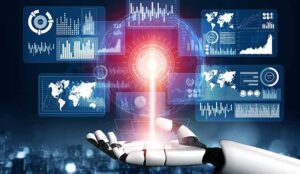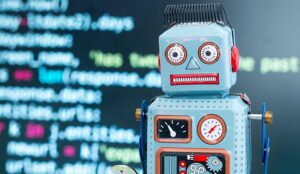Nadine Felderhoff of OBI4wan discusses the growing impact of artificial intelligence on our everyday life and how that trend is extending to the contact centre.
What is artificial intelligence? Is that a computer? A robot? A self-steering car? The future? How do the experts define artificial intelligence? Is artificial intelligence a threat to humanity or a nice addition to our daily lives?
I immersed myself in the wonderful world of artificial intelligence and learned more about this amazingly interesting subject. Are you ready for a short AI course? Then read on!
Artificial Intelligence in Your Daily Life
Without being aware of it, artificial intelligence is all around you, and you use it on a daily basis. Did you know that the following examples are all a form of artificial intelligence?
- Tagging friends through face recognition on social media
- Talking to chatbots via a website
- The navigation device in your car
- The conversation you have with Google Assistant about a delivered package
- The suggestion Netflix makes for you based on your preferences and previously viewed television series or movies
- The self-driving car
- Robots that help surgeons detect tumours.
AI is designed to make our lives easier, so you may not even notice that you are dealing with it. The best-known and most-mentioned example of AI is the self-driving car.
An Example: Chatbots as a New Form of Communication
A chatbot is a good example of an artificial intelligence solution. This virtual employee helps webcare teams to answer frequently asked customer questions and can be used in different ways.
For example, when answering simple questions or doing routine jobs. Sometimes a chatbot itself also solves customer questions from A to Z. Frank Smit (CIO at OBI4wan) is an expert in the field of artificial intelligence.
Frank explains why smart chatbots are a form of artificial intelligence: “Chatbots must understand what the user means by his or her message, so that they can respond to it. Chatbots use AI for this, via machine learning.”
“In addition, a chatbot must plan the dialogue. This is another form of AI.”
The Development of Artificial Intelligence in a Nutshell
To really understand AI we have to go back in time. The science of what artificial intelligence is goes back to 1930, when the British mathematician Alan Turing invented a machine, the forerunner of the computer as we know it today.
Yet it was not until 1955 that computer scientist John McCarthy defined artificial intelligence as follows: “Artificial intelligence is defined as the ability of a computer program or machine to think, learn and make decisions.”
Artificial intelligence, according to McCarthy, is the ability of a computer program or machine to think, learn and make decisions.
Since McCarthy, there have been several peak moments in history, such as the introduction of computer program Eliza in 1964, a chatbot that was first able to have a ‘conversation’ with a person through natural language processing (NLP).
She did this by cleverly repeating a person’s input, making it seem as if she understood the text correctly. Eliza was the forerunner of the advanced chatbots we know and use today.
It takes until 1997 before the next breakthrough when IBM’s chess computer Deep Blue wins a chess match of chess legend Garry Kasparov for the first time ever.
No one had ever thought this was possible. After this world news, developments go fast and more successes follow.
Rule-Based Techniques Versus Machine Learning
There are different types of artificial intelligence. Every computer program that makes decisions is a form of artificial intelligence. In the past, this was done by building up a lot of rules, for example by recognizing faces through pixels.
This form of artificial intelligence is based on rule-based techniques and is the ‘old-fashioned’ form of AI. Now AI is shifting more to data, so that a computer learns to recognize patterns itself. This is what is called machine learning. These patterns are used to classify and predict, using algorithms.
Deep Learning and Neural Networks
But what exactly is the difference between machine learning and deep learning? Machine learning is a form of artificial intelligence where you learn patterns based on data, and deep learning is a methodology of a deep neural network that turns out to work well.
Deep learning is therefore part of machine learning. For deep learning you need a very large set of data. Deep learning is so called because the neural networks (the building blocks of an artificial brain) consist of many layers and each layer has a different function.
When recognizing images, the first layers are for recognizing lines and edges and the later layers recognize more complex things like an eye or a nose.
With deep learning you literally learn deeper than what can only be seen on the surface.
And those neural networks? How should we understand them? Neural networks are actually algorithms and data structures designed to enable machines to classify and predict outcomes based on a range of information.
The neural network is similar to the analog structure of the brain, which consists of nodes (brain cells), connections and weights. Neural networks are usually very complicated (just like the structure of our brain) and require a lot of computing power to train.
Reinforcement Learning: AlphaGo from Google
Another important field of research within AI is reinforcement learning. Reinforcement learning (RL) is a type of machine learning technique.
This involves learning algorithms in an interactive environment by means of trying things out, repeatedly testing and forming hypotheses using feedback from one’s own actions and experiences. A bit similar to how a child learns.
The successful AI research group Deep Mind, founded by Google, taught a computer to play against itself and to recognize patterns by playing the game Go.
With this complicated variant of chess there are more possible moves. It was always thought that the grand master in GO, Lee Sedol, was unbeatable, but AlphaGO proved the opposite!
This highlight in the development of artificial intelligence has certainly also contributed to the fact that data-driven AI has become very large.
Artificial Intelligence: Opportunity or Threat?
Will robots take over the world in a few years? Should we be afraid of losing jobs or will it not go at such a rate? And what about justifying our privacy?
These questions are regularly asked when it comes to artificial intelligence. Professor ‘machine learning’ Max Welling is also asked the question on a daily basis.
Welling researches speech recognition for mobile phones and image recognition for car cameras but does not believe in robots that take over the world.
Other experts are also more convinced of the power of artificial intelligence than the threat. We can focus better on the possibilities and opportunities that AI offers.
Because there are plenty of opportunities! You can define a specific problem for everything, as long as there is a clear question and available data. The problem can then be linked to an intelligent solution that works well. The possibilities of AI are endless!
Author: Robyn Coppell
Published On: 27th May 2020 - Last modified: 4th Nov 2020
Read more about - Guest Blogs, OBI4wan, Videos

































